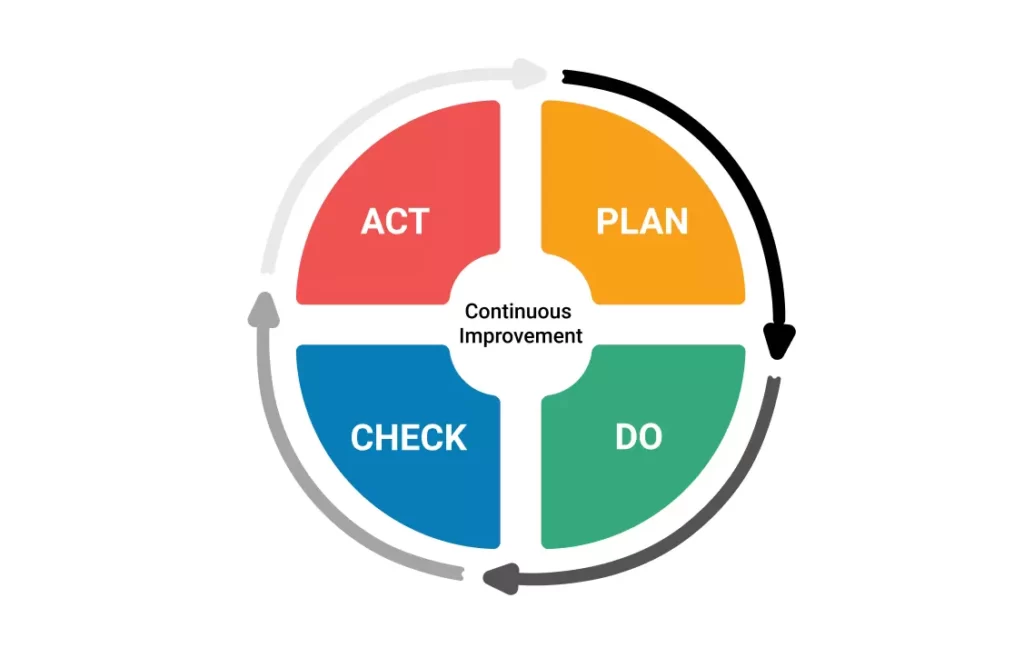The Plan-Do-Check-Act, PDCA Cycle
In today’s world, organizations face numerous challenges, and to remain competitive, they must continuously strive for improvement. Improvement is a continuous process that involves identifying problems and implementing solutions. The Plan-Do-Check-Act (PDCA) cycle is a problem-solving approach that can help organizations achieve continuous improvement. This model was developed by Dr. W. Edwards Deming, an American statistician, and quality guru. In this essay, we will explore the PDCA cycle and its various components, its benefits, and how it can be applied in an organizational setting.

What is the PDCA Cycle?
The PDCA cycle is a problem-solving approach that involves four stages: Plan, Do, Check, and Act. This cycle is also referred to as the Deming cycle or the Shewhart cycle, named after Walter A. Shewhart, who first introduced the concept in the 1920s.
The PDCA cycle is a continuous improvement model that is used to improve processes, products, and services in an organization. It is an iterative process that involves defining the problem, identifying the root cause, implementing a solution, and verifying that the solution is effective.
The Four Stages of the PDCA Cycle
1. Plan: The first stage of the PDCA cycle involves planning. This stage involves defining the problem, identifying the root cause, and developing a plan to solve the problem. The planning stage is critical as it lays the foundation for the entire process.
In this stage, the problem is defined clearly and concisely. The problem statement should include information about the scope, severity, and impact of the problem. The root cause of the problem is then identified using various tools such as the Fishbone diagram, Pareto chart, or 5-why analysis.
Once the root cause has been identified, a plan is developed to solve the problem. The plan should include specific objectives, timelines, and resources required to implement the solution.
2. Do: The second stage of the PDCA cycle involves implementation. This stage involves putting the plan into action. The implementation stage is critical as it involves executing the plan in a controlled manner.
In this stage, the solution is implemented according to the plan developed in the planning stage. The implementation process should be monitored closely to ensure that it is executed correctly. Any deviations from the plan should be addressed promptly.
3. Check: The third stage of the PDCA cycle involves checking. This stage involves verifying that the solution is effective. The checking stage is critical as it determines whether the solution has solved the problem.
In this stage, the results of the implementation process are evaluated against the objectives set in the planning stage. The effectiveness of the solution is measured using various tools such as statistical process control charts, customer feedback, or surveys. If the solution is found to be effective, the process moves to the next stage. If not, the process returns to the planning stage to develop a new plan.
4. Act: The fourth stage of the PDCA cycle involves acting. This stage involves implementing the solution on a larger scale. The act stage is critical as it involves ensuring that the solution is sustainable and that the organization can benefit from it in the long run.
In this stage, the solution is implemented on a larger scale. The process is monitored closely to ensure that it is executed correctly. The solution is then integrated into the organization’s standard operating procedures. Finally, the solution is evaluated periodically to ensure that it is still effective.
Benefits of the PDCA Cycle
The PDCA cycle has several benefits for organizations, including:
1. Continuous Improvement: The PDCA cycle is a continuous improvement model that allows organizations to identify problems and implement solutions in a systematic manner.
2. Problem Solving: The PDCA cycle is a problem-solving approach that allows organizations to identify and address problems effectively. By using the cycle, organizations can identify the root cause of a problem, develop a plan to address it, implement the plan, and verify its effectiveness. This process helps organizations to make data-driven decisions and avoid making decisions based on assumptions or intuition (1).
3. Efficiency: The PDCA cycle helps organizations to improve their efficiency by identifying and eliminating waste in their processes. By analyzing the data collected during the checking stage, organizations can identify areas that need improvement and make changes to reduce waste and increase efficiency.
4. Employee Engagement: The PDCA cycle encourages employee engagement by involving employees in the problem-solving process. By involving employees in the planning and implementation stages, organizations can benefit from their knowledge and expertise. This approach also helps to foster a culture of continuous improvement within the organization.
5. Customer Satisfaction: The PDCA cycle helps organizations to improve their products and services, which in turn can lead to increased customer satisfaction. By using customer feedback to identify areas for improvement, organizations can make changes that will improve the quality of their products and services.
Applying the PDCA Cycle in an Organizational Setting
The PDCA cycle can be applied in various organizational settings, including manufacturing, healthcare, education, and service industries. The following are the steps for applying the PDCA cycle in an organizational setting:
- Define the problem: The first step is to define the problem clearly. The problem statement should include information about the scope, severity, and impact of the problem.
- Identify the root cause: The next step is to identify the root cause of the problem. This can be done using various tools such as the Fishbone diagram, Pareto chart, or 5-why analysis.
- Develop a plan: Once the root cause has been identified, a plan is developed to solve the problem. The plan should include specific objectives, timelines, and resources required to implement the solution.
- Implement the plan: The next step is to implement the plan according to the plan developed in the planning stage. The implementation process should be monitored closely to ensure that it is executed correctly.
- Check the results: The results of the implementation process are evaluated against the objectives set in the planning stage. The effectiveness of the solution is measured using various tools such as statistical process control charts, customer feedback, or surveys.
- Act on the results: If the solution is found to be effective, the process moves to the next stage. If not, the process returns to the planning stage to develop a new plan. Once the solution is found to be effective, it is implemented on a larger scale, and the process is monitored to ensure that it is executed correctly.
Conclusion
The PDCA cycle is a problem-solving approach that can help organizations achieve continuous improvement. It involves four stages: Plan, Do, Check, and Act. By using the cycle, organizations can identify problems and implement solutions in a systematic manner. The PDCA cycle has several benefits, including continuous improvement, problem-solving, efficiency, employee engagement, and customer satisfaction. The cycle can be applied in various organizational settings, including manufacturing, healthcare, education, and service industries. By applying the PDCA cycle, organizations can make data-driven decisions and continuously improve their processes, products, and services.


